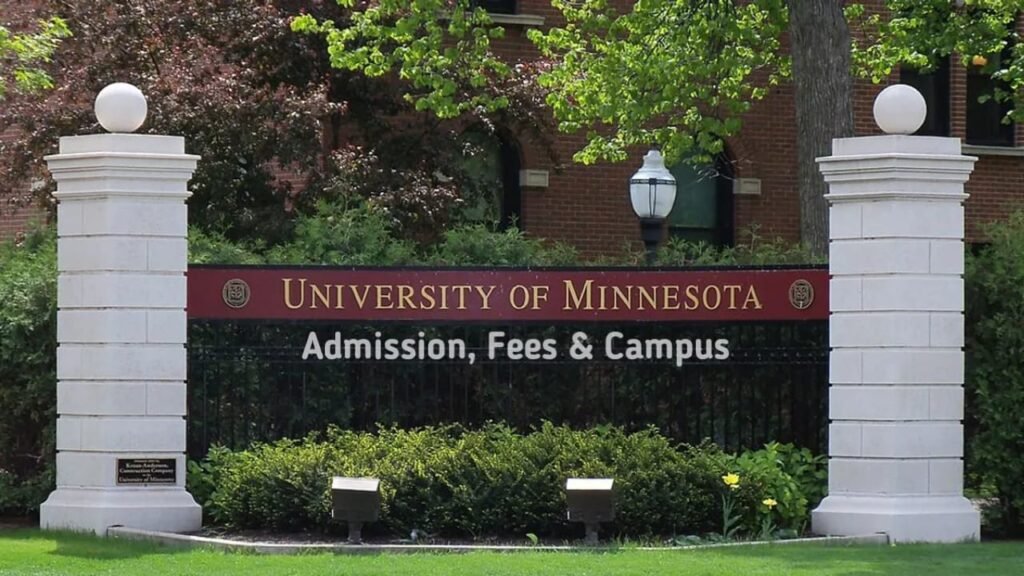The University of Minnesota, Twin Cities, located in the lively cities of Minneapolis and St. Paul, is a top public university in the United States. Known for its excellent academic programs, vibrant student life, and cutting-edge research, it attracts students from around the world. Whether you’re an Indian student dreaming of studying abroad or someone seeking a dynamic campus experience, this guide covers everything you need to know about the University of Minnesota, including admission fees, the application process, and why it’s a great choice.

Why Study at the University of Minnesota?
The University of Minnesota offers over 150 undergraduate majors and more than 200 graduate programs. Popular fields include engineering, business, computer science, psychology, and biological sciences. The university is a leader in research, giving students opportunities to work on real-world projects, from developing new technologies to solving global challenges. Its “Driven to Discover” motto reflects its focus on innovation and hands-on learning. The Twin Cities campus spans 1,204 acres, blending urban energy with scenic beauty along the Mississippi River. With state-of-the-art facilities like Walter Library and modern labs, students have access to top resources. The university is also part of the prestigious Big Ten Academic Alliance, ensuring high-quality education. Its global ranking, #203 in QS World University Rankings 2025 and #87 in Times Higher Education 2025, makes it a respected choice for students worldwide.
Admission Process for International Students
Applying to the University of Minnesota is straightforward, but preparation is key. The university has a moderately selective admission process with a 77% acceptance rate, meaning about three out of four applicants are admitted. Here’s a step-by-step guide to the application process:
- Choose Your Application Platform: Freshmen can apply through the Common App or the university’s Golden Gopher Application. Transfer students use the Common App, while graduate students apply via the University of Minnesota Application portal.
- Submit Required Documents: For undergraduates, you need to self-report your high school grades through the Courses and Grades section of the Common App. International students, including those from India, must submit Class 10 and 12 marksheets and proof of English proficiency (IELTS: 6.5, TOEFL iBT: 79, or equivalent). Graduate applicants need a bachelor’s degree, transcripts, and program-specific requirements like a statement of purpose (SOP) or letters of recommendation (LOR).
- Standardized Tests: The university is test-optional for undergraduates through Fall 2027, so SAT (1310–1480) or ACT (27–31) scores are not mandatory but can strengthen your application. Graduate programs may require GRE or GMAT, depending on the course.
- Application Deadlines: For undergraduates, there are three deadlines: Early Action I (November 1, decision by January 31), Early Action II (December 1, decision by February 15), and Regular Decision (January 1, decision by March 31). Nursing applicants must apply by November 1 for a rolling decision by December 15. Graduate deadlines vary by program, so check with your department.
- Track Your Application: After submitting, you’ll receive an acknowledgment within two weeks. Use the Application Tracker to check for missing items (e.g., grades, test scores, or fees). Complete applications receive a decision by the promised date.
- Confirm Enrollment: If admitted, pay a non-refundable $325 confirmation fee by May 1 to secure your spot. You’ll also need to apply for housing and complete the Admitted Student Checklist, which includes orientation and placement exams.
The university uses a holistic review process, considering your grades, extracurricular activities, and personal achievements. A GPA of 3.5 or higher (90% for Indian students) is recommended for undergraduates. For further queries, contact admissions@umn.edu.
Admission Fees and Tuition Costs
The application fee for undergraduates is $55 (around ₹4,591 for Indian students), while graduate programs charge $95 (around ₹7,930). These fees are non-refundable and must be paid online using a credit card. International students should ensure their card supports U.S. transactions to avoid payment issues.Tuition fees vary by program and residency status. For international undergraduate students, the estimated tuition for 2025–26 ranges from $36,000 to $40,000 per year (₹30–33 lakhs). Graduate programs cost between $14,000 and $65,000 annually (₹11–54 lakhs), depending on the course. For example, a Master’s in Computer Science or MBA is on the higher end. Additional costs include accommodation ($10,358–$15,728 per year), books, and personal expenses, bringing the total cost of attendance to approximately $57,224 for non-residents.The university offers scholarships to ease the financial burden, such as the Global Excellence Scholarship (up to $25,000/year) and ISSS Need-Based Scholarships ($1,500–$5,000 per semester). Indian students can also explore external options like Fulbright or Google PhD Fellowships for graduate studies. Apply early to maximize scholarship opportunities.
Vibrant Campus Life
The University of Minnesota offers a lively student experience with over 900 student organizations, including cultural clubs, sports teams, and academic groups. The Twin Cities provide endless entertainment, from theaters and museums to outdoor activities like kayaking. The campus shuttle and discounted Metro Transit pass make exploring easy. On-campus housing is guaranteed for freshmen who apply by May 1, with options like residence halls or apartments.Students can attend career fairs, networking events, and internships to boost their resumes. The university’s 17:1 student-to-faculty ratio ensures personalized support, and 36% of classes have fewer than 20 students. Diversity is a priority, with programs supporting inclusivity and equity for all.